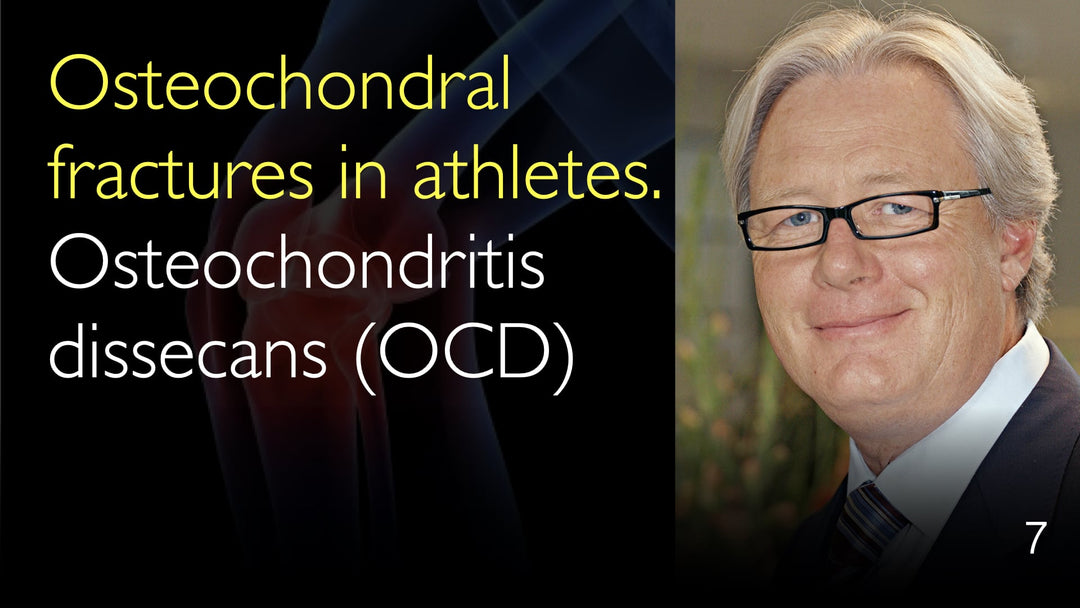Leading expert in knee surgery and cartilage repair, Dr. Matthias Steinwachs, MD, explains osteochondral fractures in athletes. He details how these injuries differ from chronic conditions like Osteochondritis Dissecans (OCD). Dr. Steinwachs describes the common causes, including patellar dislocation and ligament tears. He outlines the optimal treatment, which involves surgical re-fixation of the bone and cartilage fragment. This approach leads to excellent healing and a good outcome for patients.
Diagnosis and Treatment of Osteochondral Fractures in the Knee
Jump To Section
- What is an Osteochondral Fracture?
- Common Causes in Athletes
- Optimal Treatment Approach
- Recovery and Rehabilitation Process
- Difference from Osteochondritis Dissecans
- Full Transcript
What is an Osteochondral Fracture?
An osteochondral fracture is a specific type of knee injury. Dr. Matthias Steinwachs, MD, defines it as a fracture that removes a piece of bone and the overlying cartilage from a weight-bearing area of the joint. These are also known as flake fractures. The injury involves the subchondral bone plate, which is the layer of bone just beneath the cartilage. This combination of bone and cartilage damage distinguishes it from other knee injuries.
Common Causes in Athletes
Osteochondral fractures frequently occur in athletes due to high-energy trauma. Dr. Matthias Steinwachs, MD, identifies a traumatic patellar dislocation as a primary cause. These fractures also commonly result from severe ligament injuries, such as an ACL tear. In these cases, a fragment can be sheared off the back of the tibial head. The acute nature of these injuries means they are often seen in sports medicine and orthopedic trauma settings.
Optimal Treatment Approach
The best treatment for an osteochondral fracture is surgical stabilization. Dr. Matthias Steinwachs, MD, emphasizes that if the cartilage fragment can be re-fixed into its original anatomical position, the prognosis is excellent. Stable fixation is crucial for proper healing. This sometimes requires the use of screws to secure the bone and cartilage piece back into place. This surgical intervention provides the ideal biological conditions for the fracture to heal effectively.
Recovery and Rehabilitation Process
Recovery from an osteochondral fracture requires a dedicated rehabilitation period. As Dr. Matthias Steinwachs, MD, notes, hardware like screws often needs to be removed in a subsequent surgery. This means the overall treatment timeline includes the initial fixation surgery and a later removal procedure. Patients must follow a structured physical therapy program to restore full knee function, strength, and range of motion before returning to sport.
Difference from Osteochondritis Dissecans
It is critical to distinguish an acute osteochondral fracture from Osteochondritis Dissecans (OCD). Dr. Matthias Steinwachs, MD, clarifies that OCD is a chronic disease of the subchondral bone. Treatment for OCD focuses on addressing the underlying bone pathology, often with cancellous bone implantation to restore biology. In contrast, an osteochondral fracture is a traumatic event. The pathology is the fracture itself, not a biological failure of the bone, which is why surgical fixation typically yields a very good outcome.
Full Transcript
Dr. Matthias Steinwachs, MD: Knee injury frequently involves not only damage to ligaments, patella, and meniscus. Knee trauma also involves osteochondral fractures.
What is an osteochondral fracture? How to treat osteochondral fractures, especially in athletes?
Osteochondral fractures are fractures which remove part of bone and cartilage from the loaded area of the joint. We see that after a traumatic patellar dislocation. So it is called flake fractures.
The etiology of an osteochondral fracture is an acute high-energy trauma, which removed a piece of cartilage in combination with a subchondral bone plate. We see osteochondral fractures many times in athletes.
We also see some flake fractures after traumatic tear of the knee ligaments caused by ligament injuries. So this is also one of the factors where we can see osteochondral fractures.
Sometimes we see osteochondral fractures also in the back of the tibia bone head after an ACL tear. So these are many locations of osteochondral fractures.
The good thing is the osteochondral fractures mostly heal very actively compared to a chronic knee problem. Suppose we can re-fix that cartilage fragment into the right place.
If we can fix osteochondral fractures in a stable way, you have the best situation. Then osteochondral fracture heals mostly properly.
But in some cases, you have to use screws to fix osteochondral fractures. You have to remove the screws later on. So for that reason, after osteochondral fractures, a patient also needs time for rehabilitation.
Osteochondral fractures are quite different from other osteochondral defects. We also see osteochondral defects in the field of our back. We see that in the OCD.
We see many reasons, but the pathology in the osteochondritis dissecans (OCD), for example. Osteochondritis dissecans (OCD) is a disease of a subchondral bone.
We have to address therapeutically that with cancellous bone implantation to enhance the biology under subchondral bone properly. Because this is the reason why osteochondral disease is starting.
To stop and heal osteochondritis dissecans (OCD), you have to address the pathology in the subchondral bone. In the case of osteochondral fracture, the pathology is not in the subchondral bone.
The problem is the fracture itself is easily fixed. Osteochondral fracture treatment gives a good outcome, mostly.




